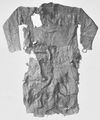Tunics
Tunic material
... made of wool
... made of linen
... made from different coloured cloth
Tunics made from different types of cloth each a different colour
Knee length rucked tunics with tight rucked sleeves and unfaced rounded neck
Art
- Anglo-Saxon Manuscripts
- Of the xx manuscripts dated from 900 to 1066AD that show clear tunic lengths the following results can be noted:
- To top of knee or above: 21 manuscripts
- To middle of knee: 15 manuscripts
- To bottom of knee: 5 manuscripts (most being post 1050AD)
Literature
--
Archaeology
- In the 10th- 11th Century
- Dalmatic (tunic) of St. Ulrich (Germany), died in 973 Made of byzantine silk. The Tunic is 101cm wide and 143cm long, the sleeves are 50.5cm long. [Zwittmeier 2014]
- Kragelund (Denmark) 1040-1155
- Moselund (Denmark)1050-1150
- Skjoldehamn (Norway) ~1025
- Guddal (Norway) 1035-1165
- Viborg shirt (Denmark) 11th C
- Heinrich II tunic early 11thC
- pre-dating the Viking age
- Thorsberg (C4th)
- Bernuthsfeld (680–775AD)
- Lenbreen tunic (Norway glacier)
- Post-dating the Viking age
- Shirt of St. Louis (France) 13th C
- Francis of Assisi (Italy) multiple tunics early 13th C
- Thomas Becket vestments, including a shirt (Sens, France) 12th C
- Ronbjerg Mose (Denmark) 13th C
- St. Bernulf shirt (Utrecht, Netherlands) 12th C
- Bocksten Man (Sweden) late 14th C
Discussion
Tunic length reconstructions are primarily based on Anglo-Saxon manuscripts. No tunics are shown to end between the knee and ankle.
A ankle length robe type garment is often shown being worn by aristocratic men sitting down.
... with visible belts
Art
- Depictions of Vikings in the 10th / 11th centuries show them wearing knee length tunics????????
Literature
--
Archaeology
--
Discussion
This is based on the assumption that the Vikings seem to wear leather belts with decorative fittings and plates. There would be no point in this kind of belt being worn if it were not visible.
For examples of elaborate belts see ‘Men’s Belts, Bags & Accessories’
... with unrucked sleeves
Art
--
Literature
--
Archaeology
--
Discussion
--
... shorter tunics
Art
--
Literature
--
Archaeology
--
Discussion
--
... with decoration
Art
--
Literature
--
Archaeology
--
Discussion
--
Knee length rucked tunics with tight rucked sleeves and faced square keyhole neck
Art
- Anglo-Saxon
- T58 c.1000AD :p.53, p,59;
- T64 1025-1050AD
- T66 1012-1023AD :f.93r;
- T78:f.6r;
- T87
- T98:
- T103 after 1073AD
Literature
--
Archaeology
--
Discussion
Ewing has put forth a view that this style of tunic may have been introduced by the Danish.
... with decoration
Art
- T66 f.93r Goliath. Band of decoration across the mid skirt with outlying circle cluster in groups of 5 in a cross shape. Possible band of decoration across the chest.
- T103 f.4r Gemini (left). Band of decoration across the mid skirt with outlying circles. Similar decoration is seen on two other zodiac figures, both depicted with non-keyhole, non-faced standard rounded neck holes.
Literature
--
Archaeology
--
Discussion
--
Knee length rucked tunics with tight rucked sleeves and round faced keyhole neck
Art
--
Literature
--
Archaeology
--
Discussion
--
... with decoration
Art
--
Literature
--
Archaeology
--
Discussion
--
... with European style facing
Art
--
Literature
--
Archaeology
--
Discussion
--
Shin length rucked tunics with tight rucked sleeves and round keyhole neck
These first appear after about 1025AD? – Harley.
Art
--
Literature
--
Archaeology
--
Discussion
--
Ankle length rucked tunics with tight rucked sleeves
Art
--
Literature
--
Archaeology
--
Discussion
Seen on aristocratic...

